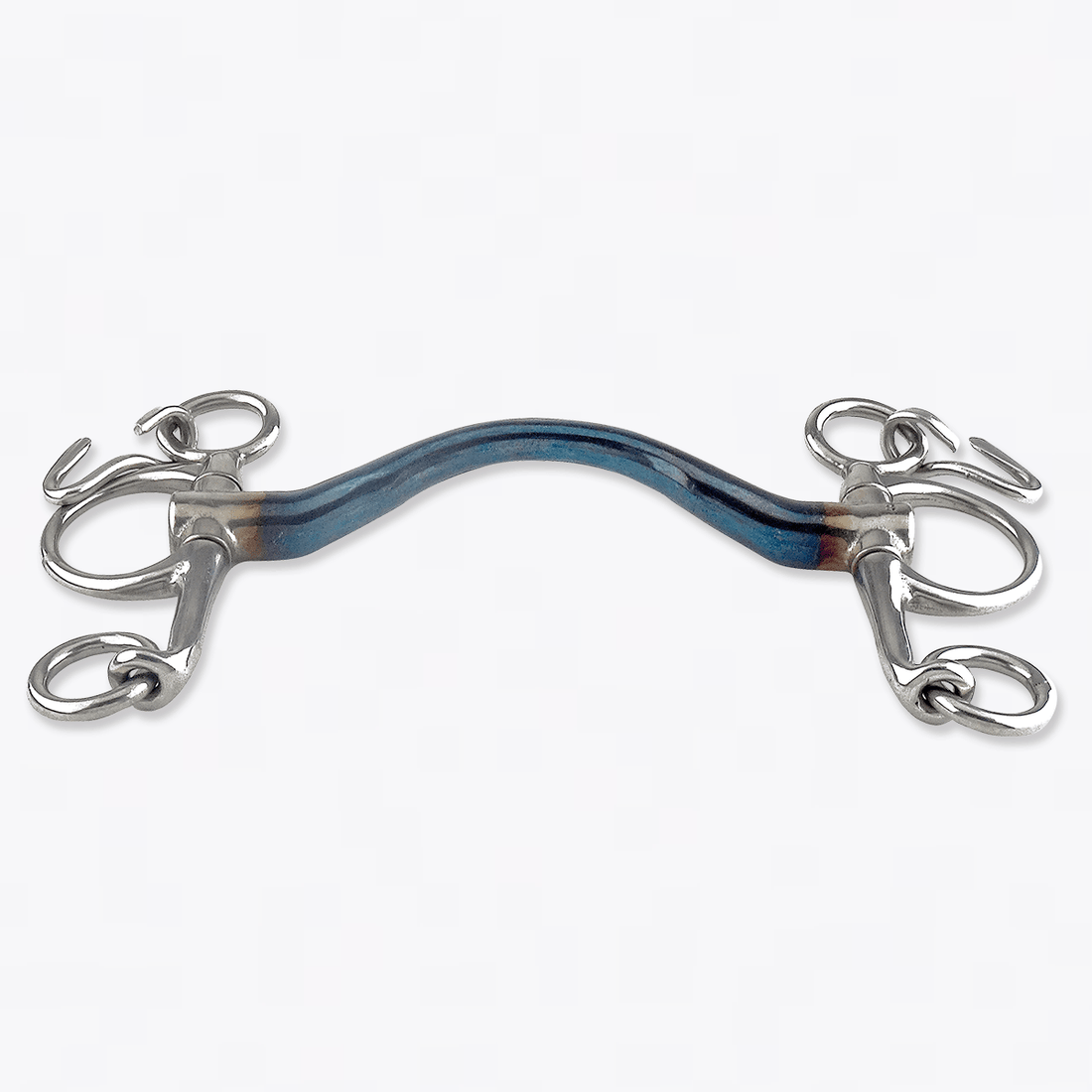Loose Ring Large
This cheekpiece has loose rings which allow the bit to move more freely in the mouth to make that many horses accept this bit well. Because of the loose rings, the aid is conveyed indirectly. The large rings provide greater pressure distribution on the cheeks. This makes a horse easier to turn. In addition, a slight leverage effect can be obtained with these large rings. The bigger the rings are the slower your aid will come through.

Eggbut port medium
The rings of the eggbut cannot move separately from each other, so the riders aid is conveyed directly and the bit lies stable in the horse’s mouth.
The Port Medium is slightly flexible. This mouthpiece has a port that creates space for the tongue and decreases the pressure on the centre of the horse’s tongue.

Medium Port
This is a straight mouthpiece with a medium port. The port allows freedom of the tongue. The port creates space for the tongue and decreases the pressure on the centre of the horse’s tongue. More tongue freedom is ideal for horses that have a sensitive tongue or horses that stick out the tongue.
Loose Ring Gag
The loose ring gag stimulates the horse to bring its head up. It is often used with horses that run behind the bit and don’t follow the hand as much as necessary. The bit can be used with one or two reins or with pelham straps. In most cases, the bit is used with two reins, one is normally attached to the bit and the other rein to the end of the gag straps.

This bit is not for inexperienced riders.
French Link
The french link mouthpiece is a double-jointed mouthpiece with a figure-eight-shaped plate in the middle that exerts equal pressure on the tongue. This mouthpiece has two hinge points, is shaped more towards the mouth and lies somewhat looser in the mouth.

Weymouth non – fixed
A weymouth non-fixed is used together with a bradoon, the so-called double bridle. Because of the pumping effect there is more movement in the bit compared to the normal weymouth. The horse can lift the bit slightly to reduce the pressure on the tongue. The weymouth is a cheekpiece with leverage. The longer the shanks the sharper the effect. The weymouth non-fixed has long shanks and therefore is a stronger bit than the baby weymouth non - fixed. In addition, this cheekpiece must always be combined with a curb chain to prevents the bit from rotating too far in the horse’s mouth.

Arched
An arched mouthpiece is a straight mouthpiece that is slightly bent. Because of the forward bend in the bit there is room for the tongue. This mouthpiece exert even pressure on the complete mouth.

Loose Ring Bradoon
This cheekpiece has loose rings which allows the bit to move more freely in the mouth so that many horses accept this bit well. Because of the loose rings, the aid is conveyed indirectly. Small rings have a faster effect than larger rings. The smaller the rings, the more pressure is transferred to a smaller surface area. In combination with a 12mm mouthpiece a bradoon is used in combination with a weymouth, so there are two different bits in the horse’s mouth at the same time. The rings of a bradoon are smaller so that there is enough space for the weymouth.

Mullen
The Mullen is a straight bar that slightly bends forward. The bit has a rigid core that makes the mullen bar not flexible but the material around it gives the bit a soft touch.

3 Ring
A 3 ring bit also called pessoa bit is a bit with a leverage effect. The lower the reins are placed, the stronger the bit becomes. An ideal bit for horses that are very strong or hold the bit. It can happen that horses ridden on a 3 ring are walking more on the front legs after a while. This bit is not for inexperienced riders.

Eggbut Jointed
This bit is used for young horses to keep it as simple as possible but also for horses which don't like the pressure on the middle of the tongue like with an elliptical mouthpiece. Another important thing: The nutcracker effect is a myth. This is only possible if your bit is way too long.

Loose ring
The loose ring has loose rings which allows the bit to move more freely in the mouth so that many horses accept this bit well. Because of the loose rings, the aid is conveyed indirectly.
To prevent lips from getting pinched, it is advisable to provide the bit with bit rings.

Swivel
This bit has two half rings which are connected with each other and gives more control than normal rings. The mouthpiece has limited freedom of movement because it is attached to the cheekpiece between the half rings. The swivel has several options for attaching the reins. You can decide how much pressure you want to apply. The bridle is attached to the upper half ring and the reins can be attached to the large ring or to the lower half ring. By attaching the reins to the large ring, pressure is applied to lower the horse's head. When the reins are attached to the half ring, the bit has a mild leverage for better responsiveness.
Cherry Roller
Do you have a horse which taking hold on the bit and start pulling?
Maybe you can try a Cherry Roller mouthpiece.
The cherry roller mouthpiece consists of loose rolls. These rolls prevent the horse from taking hold of the bit. This makes it an ideal bit for horses which hold the bit with their teeth and pulling forward.
Waterford
A waterford mouthpiece consists of a series of rounded links. It is a flexible bit that forms towards the horse's mouth and creates an even pressure. It can move in all directions making it difficult for the horse to lean on the bit so that the rider retains proper control. This bit is not suitable for inexperienced riders. In soft hands this mouthpiece is friendly but with a strong hand the bit can be sharp.
Locked
The locked mouthpiece resembles a jointed mouthpiece but cannot fold as much as a jointed bit. When pressure is applied on the reins, the bit locks, transforming it into a straight bar and making it a sharper bit. With less pressure on the reins, the bit changes back into a jointed bit. This makes it an ideal bit for horses that are against the hand.
Eggbut Port Medium
.
There are a lot of horses that don't like the pressure on the tongue. They show it by putting the tongue out of the mouth or trying to put it above the bit. For those horses we often recommend ported bits. The port medium has a medium flexibility and is especially for sensitive horses who can get a bit strong so a flexi soft would not guarantee enough grip.
Eggbut Flexi Soft
This is the perfect bit for horses that have problems accepting the bit or young horses. This mouthpiece is soft and flexible, giving these horses more trust in the bit and the rider’s hand. Due to the eggbut cheekpiece the bit lays stable inside the mouth which helps a direct connection between rider and horse. If you have a very hot horse or a horse which chews a lot on the bit we advise to take another bit.
Jointed
A jointed bit has one hinge point, which means less pressure on the tongue than with a eliptical mouthpiece. A jointed mouthpiece exerts pressure mainly on the layers and the side of the tongue.



